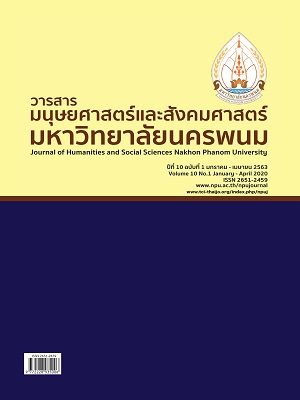A Signal of Klong-phel Drum The Inheritance and Ethical Value on I-san Community Way of Life
Main Article Content
Abstract
This research is the participatory action research (PAR) in order to 1) study problems and situations of Klong-phel drum and its signal, 2) study a relationship between a signal of Klong-phel drum and ethical values on I-san community way of life, and 3) create a pattern of conservancy, inheritance and spread of Klong-phel cultures on I-san community way of life widely with Phangkhang people. The sample groups, 250 persons in Phangkhang sub-district, Meuang district, Sakonnakhorn province, are selected. Main research instruments for this research are the interview schedule and schedule for focus group. Data are collected during August 2017 – August 2018 and analyzed after finishing a seminar of participatory action research on all steps.
The results of this study reveal that: 1) Problems of Klong-phel drum conservancy consist of (1) monks and people don’t take care of it and (2) monks and people don’t know how to repair it. For situations of Klong-phel drum beating, it is revealed that at the first Klong-laeng beating and Klong-duek beating, the secondary Klong-phel beating (at 11.00 am.) and Klong-hom beating, the third Klong-ngan beating, and finally Klong-tuang beating. On the other hand, problems of Klong-phel drum beating have clearly changed to a low level because of (1) Klong-phel drums are ruined, (2) monks place importance on Klong-phel cultures’ value at low level, (3) people also place importance on Klong-phel culture’s value at low level, and (4) at present it is globalization time. 2) A signal of Klong-phel drum can create the internal ethical value, namely the good conscious mind and the external ethical value, namely the good behaviour or characteristic and the good community for people. And 3) Pattern of conservancy, inheritance and spread of Klong-phel cultures, it composes of (1) signifying the importance of Klong-phel cultures, (2) advising the right methods on beating, taking care, maintaining and self-conducting, (3) showing or demonstrating the right methods on beating, taking care, maintaining and self-conducting (4) training and testing on Klong-phel drum beating rightly, and (5) conducting the projects and activities to conserve, inherit and spread Klong-phel cultures.
Moreover, results of this study have created the center of learning and conserving Klong-phel drum, Phangkhang sub-district, at Wat Nonsawan. Herewith, there is also a model place of conservancy, inheritance and spread of Klong-phel cultures. Thereby, Buddhist and government institutes should mostly support and spread it to other places.
Article Details
References
พระมรกต อิสฺสโร. (2561, 11 สิงหาคม). เลขานุการศูนย์เรียนรู้และอนุรักษ์กลองเพล ตำบลพังขว้าง. [สัมภาษณ์].
พระอธิการนิวัฒน์ ธมฺมวโร. (2561, 18 มิถุนายน). เจ้าอาวาสวัดป่าพังขว้างใต้. [สัมภาษณ์].
พระอริยานุวัตร เขมจารี. (2536). อริยานุวัตรณุสรณ์. ที่ระลึกในงานพระราชทานเพลิงศพ พระอริยานุวัตร เขมจารี. มหาสารคาม: มหาวิทยาลัยศรีนครินทรวิโรฒ มหาสารคาม.
มงคล จันทราภรณ์. (2553). แบบจำลองทางคณิตศาสตร์ของเสียงที่เกิดจากกลองเพลง. วิทยานิพนธ์ปริญญาวิทยาศาสตร์มหาบัณฑิต (ฟิสิกส์) คณะวิทยาศาสตร์ มหาวิทยาลัยราชภัฏอุบลราชธานี.
มหาจุฬาลงกรณราชวิทยาลัย. (2558). ปรัชญาเบื้องต้น. พิมพ์ครั้งที่ 4. กรุงเทพฯ: มหาจุฬาลงกรณราชวิทยาลัย
วิทยา สายสุด. (2536). สื่อสัญญาณพื้นบ้านอีสานในเขตอำเภอหัวตะพาน. วิทยานิพนธ์ปริญญาศิลปศาสตรมหาบัณฑิต วิชาเอกไทยคดีศึกษา. มหาวิทยาลัยศรีนครินทรวิโรฒ มหาสารคาม.
เอกลักษณ์ บุญท้าว. (2544). สารัตถะแห่งความคิด เล่ม 3. มหาสารคาม: อัดสำเนา.
เอกลักษณ์ บุญท้าว และคณะ. (2545). สภาพการถ่ายทอดและสืบทอดภูมิปัญญาท้องถิ่นอีสาน ด้านการละเล่น กลองเส็ง ในอำเภอร่องคำ จังหวัดกาฬสินธุ์. สำนักงานคณะกรรมการวัฒนธรรมแห่งชาติ กระทรวงศึกษาธิการ
Bignell, Jonathan. (1997). Media Semiotics: An Introduction. New York: Manchester University Press.
Translated Thai References
Boontown, E. (2001). Essence of Thought Vol. III. Mahasarakham: Copy Paper. [in Thai]
Boontown, E. et al. (2002). The Transference and Heirloom of I-Sarn Local Culture, Klong-Seng, Tomtom Competition in Rongkham District, Kalasin Province. Office of the National Culture Commission, Ministry of Education. [in Thai]
Jantraporn, M. (2010). Mathematical Modeling of Sounds for Klong Pane. M.S. Thesis in Science Education (Physics). UbonRatchathaniRajabhat University, Thailand. [in Thai]
Khoasodonline. (2016). Do You Know? “Klong-laeng Beating” is to Inform People Coming to Temple – to Announce to Devas that Now Buddhism Exists. Retrieved November 2017, from http://www.khaosod.co.th/view_sonline.php? newsid= 1468298712. [in Thai]
Mahachulalongkornrajavidyalaya. (2015). Introduction to Philosophy. (4th Ed.), Bangkok: Mahachulalongkornrajavidyalaya. [in Thai]
Phra Ariya Khemacaree. (1993). Ariyanuwatnusarana. A Remembrance for Funeral of Phra Ariyanuwat Khemacaree. Mahasarakham: Srinakharinwirot University Mahasarakham. [in Thai]
Phra Athikarn Niwat Dhammawaro. (2018, June 18). Abbot of Wat Paphangkhangtai. An Interview. [in Thai]
Phra Morakot Issaro. (2018, August 11). Secretary of a Center of Learning and Conserving Klong-phel Drum, Phangkhang Sub-district. An Interview. [in Thai]
Saissuid, W. (1993). Isan Folk Sound-producing Media in AmphoeHuataphan. M.A. Thesis in Thai Studies (Humanities). Srinakharinwirot University Mahasarakham, Thailand. [in Thai]

